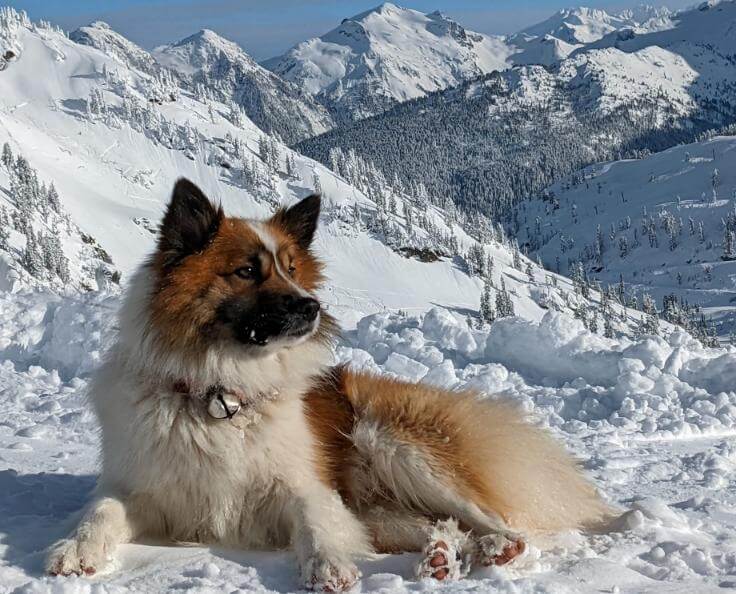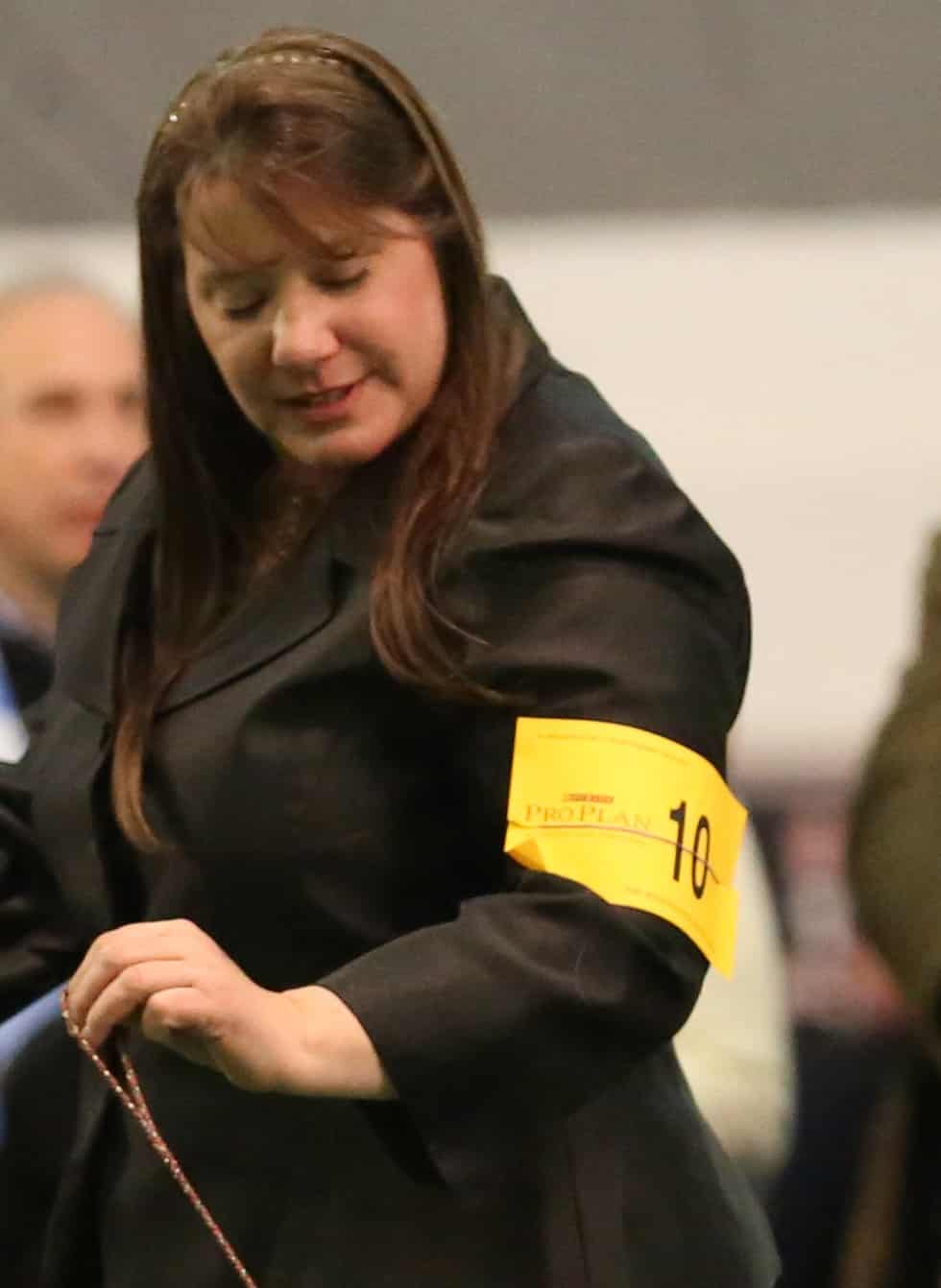Interview with Herding Group Breeders Jo-Ann Secondino & Jonathan Pickett
Where do I live? How many years in dogs? How many years as a breeder?
My partner, Jon, and I have been raising Icelandic Sheepdogs for nearly 19 years.
What is my kennel name? How many dogs do I currently keep?
Jo-Ann Secondino & Jonathan Pickett: In our rural Maryland home, we live with five generations of the “Double Dew Crew” who are a constant source of entertainment. I breed under the name of Fox Meadow Icelandics; Jon has adopted Alfagardur Icelandics as his own. It has been such a rewarding experience to work with breeders and owners across the US and overseas, importing dogs and semen to the US, as well as sending dogs and semen back to Europe in an effort to preserve and steward the breed for future generations. I’ve had the opportunity to serve my breed community in the US as Vice President, Breeding Committee, and Health & Genetics Chairman of the the Icelandic Sheepdog Association of America, the parent club for the breed. Jon and I regularly create fundraising opportunities for NISRA, our breed rescue, and the international breed cooperative. In 2019-2020, we had the honor to have our puppy, Fox Meadow Runestone Stormasom Nott, “Storm,” represent the Icelandic Sheepdog and the Herding Group as part of the AKC Puppy Pack 2.0, where we made more friends in the purebred community.
Which show dogs from the past have been my noteworthy winners?
Jo-Ann Secondino & Jonathan Pickett: We are proud of all of our puppies. Some have competed and been ranked in Performance sports, earned Search and Rescue certification, or worked with special needs children in addition to those that compete in Conformation. Some of our stand-out show dogs have been GCHS Fox Meadow Hausti Solstafir, who was the first Icelandic Sheepdog to earn a ribbon in an AKC ring as a fully-accepted breed in June of 2010, winning his Puppy Class under Judge Walter Sommerfelt. “Solstafir” went on to earn Best of Opposite Sex and Select Dog awards later at Westminster Kennel Club Dog Shows. CH Isi Kaffisukulathi, “Kaffi,” became the first male Icelandic Sheepdog to Champion in the first week of AKC acceptance, earning all points from Best of Breed majors. He went on to become the #3 Icelandic Sheepdog, with very limited exhibition, and introduced the breed to the 2010 Morris and Essex dog show. He was featured as the new breed to the AKC Herding Group at the 2010 National Dog Show and the 2011 Westminster Kennel Club Dog Show where he was awarded the breed’s first Westminster Best of Opposite Sex.
Which have been your most influential sires and dams?
Jo-Ann Secondino & Jonathan Pickett: Viking Lilja, CH Thordunu Leppatuska (best-known ringside as “Elsie”), and CH Isi Kaffisukulath were some of my most influential sires and dams. “Lilja” was dam to multiple Champions and Performance dogs. Elsie and “Kaffi” produced the breed’s first Bred-By-Exhibitor Champion as well as Autism Support pups. When we combined Lilja, Elsie, and Kaffi’s offspring, they went on to produce grand puppies that are earning top ranking at shows in Europe, as well as ranked Performance Dogs here in the US, and working dogs. Lilja and Kaffi passed away in 2021 at 18.5 years and 15 years respectively, but their legacy lives on all over the US, Canada, and Europe. Soon, Lilja’s grandpuppy will be heading to Iceland. Lilja, Elsie, and Kaffi are great-granddam/sire to the first Icelandic Sheepdog litter born in Great Britain in nearly 50 years.
Can I talk a bit about my facilities? Where are my puppies whelped? How are they raised?
Jo-Ann Secondino & Jonathan Pickett: Icelandic Sheepdogs are very people-oriented, so we feel most comfortable raising all of our litters in our home, surrounded by our daily activities and their Icelandic Sheepdog family. (Sometimes, it really does take a village.) We offer a variety of challenges to our puppies, which increase in difficulty, to help them develop a sense of adventure and build their confidence to achieve our goal of producing well-balanced puppies that are capable of performing their traditional roles and more. As there can be a range of drive within the breed, this also helps us assess just where they would best fit in with a family’s dog ownership goals.
What is my “process” for selecting show puppies? At what age do I make my decisions?
Jo-Ann Secondino & Jonathan Pickett: We start evaluating our puppies as soon as they are born, forming opinions on proportions, head type, and angulation. We then reevaluate them at 6 and 8 weeks old. At that point, temperament, gait, and tail-set are also evaluated to help us determine which puppies would be the best prospects for the show ring.
How do I prepare my pups for the show ring? Does my breed require any special preparation?
Jo-Ann Secondino & Jonathan Pickett: Since Icelandic Sheepdogs have a requirement for dewclaws in the standard, where their quality is to be assessed in the ring, we make a point of handling their feet frequently. In addition, we teach them to be comfortable with showing their bite, and testicles are examined for the dogs.
Is my breed hand-stacked or free-stacked in the show ring? Why is it presented in this manner?
Jo-Ann Secondino & Jonathan Pickett: In recent years, the Icelandic Sheepdog has become a ramp optional breed—but it is still required to be free-stacked on the ramp. I was fortunate that the engineering department where I am employed made a ramp for me to start my young dogs on. There we can work on them being comfortable with free-stacking and exams while on the ramp or the ground. Internationally, most clubs prefer to exhibit them on the ground, as the AKC does provide the ramp to be optional for the judge. The parent club did go through the process of getting approval from the country of origin to change them to be a ramp optional breed in the AKC.
Are Performance and Companion titles important to me as a breeder? Are parent club titles?
Jo-Ann Secondino & Jonathan Pickett: It is important to me that I produce well-balanced puppies that are capable of performing their traditional role in their country of origin, Iceland. While conformation titles confirm that they may have the correct coat to protect them from the volatile weather, and the structure to work all day over rough terrain, Performance and Companion titles help to prove that our dogs have the temperament described in the standard and the drive to do the work they were bred to do, despite many never having the benefit of working stock.
In my opinion, is my breed in good condition overall? Any trends that warrant concern?
Jo-Ann Secondino & Jonathan Pickett: With careful management and leadership from the national breed club and guidance from international Icelandic Sheepdog associations, the breed has a bright future. We do need to avoid the common traps that many breeds have fallen into, those that have affected health, temperament, and performance. Thankfully, we are still a low numbers breed in the age of technology. With the ease of communication and information sharing, I have high hopes that our breed community can make choices to avoid the problems plaguing some other breeds. The Icelandic Sheepdog was fortunate to have geneticists analyze the international population and make recommendations in the 1980s which the clubs have adopted as breeding guidelines. The international Icelandic Sheepdog population is periodically reevaluated, and reports on health, emerging conditions, and population growth are shared annually with the Icelandic Sheepdog International Cooperative, an association of breed clubs from North America, Iceland, and Europe. As an international community, recommendations are then made on how to best address breed preservation.
Is my breed well-suited to be a family dog? Who are the best candidates to own my breed?
Jo-Ann Secondino & Jonathan Pickett: The Icelandic Sheepdog makes a great family dog. They are inherently gentle with children and happy to meet newcomers. They are my ideal “take anywhere/do anything” dog that I’d hoped to have. Some individuals can be quite independent, and others can have much more drive, creating challenges for owners who are unprepared for those possibilities. Barking, and reactivity accompanied by barking, can be a common complaint among owners. Team-building, to create a bond and earn their trust, can address those issues. Ideally, owners who actively train and work their dogs, creating opportunities that challenge them, usually find the breed easiest to live with.
For a bit of fun, what’s the most amusing thing I’ve ever experienced with a Herding Dog?
Jo-Ann Secondino & Jonathan Pickett: The Icelandic Sheepdog is really fun individually, but they are hilarious in groups. Traditionally, the breed would chase off raptors in Iceland that targeted the farm’s chickens and newborn lambs. This instinct has not been lost—not even a little bit. While at the annual fundraiser “Icetoberfest” for the breed’s rescue group, NISRA (an event that takes place in a fully fenced park), owners were stunned to suddenly see 40 Icelandic Sheepdogs race across the park, all barking at a single vulture silently gliding high overhead. The sight of three dozen Icelandic Sheepdogs barking in unison at a winged beast far above our heads assured the owners present that we had not only preserved and nurtured the breed instinct to protect their flock from threats from above, but we also clearly were safe from any potential danger. No one was going to sneak up on us that weekend.










